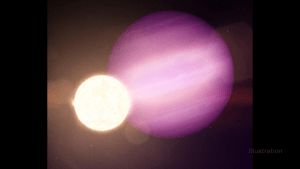Sai Rayasam, Physical Sciences, Fall 2020
Figure: This image illuminates the potential Jupiter-sized planet orbiting around its white dwarf star. White dwarfs mark the end and death of a majority of the stars. This is the first time that a planet was found intact after the cosmic explosion that ends in a star becoming a white dwarf.
(Source: NASA Images)
When a star with a similar mass to the sun runs out of nuclear fuel, it can no longer generate the outward force from nuclear fusion needed to counteract the inward force of gravity. When this happens, the star expels most of its outer materials into the abyss of space (which is known as a planetary nebula), and the rest of the star collapses into a hot core. The result is a dead, extremely dense object known as a white dwarf, which fits a mass similar to the sun into a volume comparable to Earth. Normally, planets that orbited the star would be torn apart by the immense gravitational force exerted during the creation of the white dwarf.1 But scientists have recently found evidence that it is possible for a planet to survive the violent cataclysm that turns its host star into a killer. Astronomers, led by Andrew Vanderburg of the University of Wisconsin-Madison, discovered a white dwarf called WD 1856 being orbited by a Jupiter-sized planet called WD 1856 b, which was around 7 times larger than the white dwarf around which it revolved.2
The astronomers found the star-planet system utilizing NASA’s Transiting Exoplanet Survey Satellite (TESS). The satellite searches for foreign planets by measuring the tiny dips in brightness they cause when crossing between the star and the satellite. The team then confirmed this finding using infrared light from NASA’s recently decommissioned Spitzer Space Telescope, which revealed that WD 1856 b does not emit its own infrared glow. To the trained astronomer, this lack of infrared glow means that WD 1856 b is most likely a planet.2
The fact that this planet survived the white dwarf calamity was quite puzzling to the astronomers. But they believe that WD 1856 b formed incredibly far from its star (around 50 times farther away from its current location), otherwise it would not have survived the planetary nebula created when a star emits ionized gas before condensing into a white dwarf. Furthermore, they found the planet had migrated much closer to the star than before. And although it is unclear what caused the planet to move, the astronomers believe the most likely stimulus was the gravitational influence of other Jupiter-sized bodies close to WD 1856 b’s original orbit distance. As of now, no other planets have been discovered in the WD 1856 star system.2
WD 1856 b’s existence has many exciting consequences for planetary scientists and astrobiologists. Scientists know that in about 12 billion years, our sun will become a white dwarf, and in the process it will completely engulf Mercury and Venus and utterly vaporize Earth.3 But if a gas-giant such as WD 1856 b can survive the process and still keep itself relatively the same, does that mean a rocky planet like Earth could do so as well? Vanderburg and other researchers investigated this possibility in a paper published on September 17, 2020 in The Astrophysical Journal Letters. The team, this time led by researchers Lisa Kaltenegger and Ryan MacDonals from Cornell University, used computer modeling to simulate the view that NASA’s upcoming James Webb Space Telescope could experience at a hypothetical rocky body orbiting in the star’s “habitable zone” (the range of orbital distances where liquid water could be stable on a planet’s surface) after the white dwarf process. The scientists hypothesized that Webb could detect signatures of oxygen and carbon dioxide given the right amount of time—even after the star goes through its destructive phase. Even more impressively, Webb could also detect gas combinations indicative of biological activity. This means that in the right circumstances, planets could maintain conditions favorable for life longer than predicted for Earth in the event of white dwarf creation. With this, exoplanet discovery and the search for life are greatly enhanced, and the possibility of the human race outliving our star manifests.2
References:
- Goddard Space Flight Center. (December 2010). White Dwarf Stars. NASA. Retrieved September 20, 2020 from https://imagine.gsfc.nasa.gov/science/objects/dwarfs2.html
- Wall, M. (September 17, 2020). Scientists Spot Giant Planet Orbiting Dead Star’s Corpse. ScientificAmerican. Retrieved September 20, 2020 from https://www.scientificamerican.com/article/scientists-spot-giant-planet-orbiting-dead-stars-corpse/
- Taylor, D. (June, 2012). The End Of The Sun. Northwestern University. Retrieved September 20, 2020 from https://faculty.wcas.northwestern.edu/~infocom/The%20Website/end.html
- Wall, M. (September 16, 2020). Big find! Scientists spot giant alien planet orbiting close to dead star’s corpse. Space.com. Retrieved September 20, 2020 from https://www.space.com/giant-exoplanet-found-orbiting-white-dwarf-wd-1856b.html
